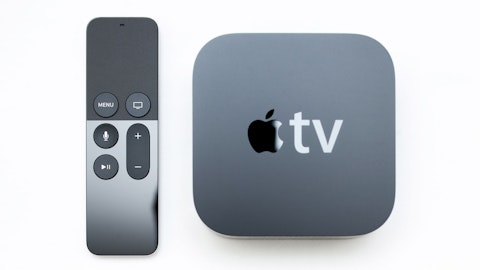fuboTV Inc. (NYSE:FUBO) Q4 2023 Earnings Call Transcript March 1, 2024
fuboTV Inc. beats earnings expectations. Reported EPS is $-0.17, expectations were $-0.25. FUBO isn’t one of the 30 most popular stocks among hedge funds at the end of the third quarter (see the details here).
Operator: Good morning. My name is Christa and I’ll be your conference operator today. At this time, I would like to welcome everyone to the Fubo Fourth Quarter Full-Year 2023 Earnings Conference Call. All lines have been placed on mute to prevent any background noise. After the speakers’ remarks, there will be a question-and-answer session. [Operator Instructions]. Thank you. I would now like to turn the conference over to Alison Sternberg, Senior Vice President of Investor Relations. Alison, you may begin your conference.
Alison Sternberg: Thank you for joining us to discuss Fubo’s fourth quarter 2023. With me today is David Gandler, Co-Founder and CEO of Fubo and John Janedis, CFO of Fubo. Full details of our results and additional management commentary are available in our earnings release and letter to shareholders, which can be found on the Investor Relations section of our website at ir.fubo.tv. Before we begin, let me quickly review the format of today’s presentation. David is going to start with some brief remarks on the quarter and full-year and Fubo strategy, and John will cover the financials and guidance. Then we will turn the call over to the analysts for Q&A. I would like to remind everyone that the following discussion may contain forward-looking statements within the meaning of the federal securities laws, including, but not limited to, statements regarding our financial condition, anticipated financial performance, business strategy and plans, industry and consumer trends, anti-competitive practices among our competitors and our response plan and expectations regarding profitability.
These forward-looking statements are subject to certain risks, uncertainties and assumptions. Important factors that could cause actual results to differ materially from forward-looking statements include those discussed in our filings with the SEC. Except as otherwise noted, the results and guidance we are presenting today are on a continuing operations basis, excluding the historical results of our former gaming segment, which are accounted for as discontinued operations. During the call, we may also refer to certain non-GAAP financial measures. Reconciliations of these non-GAAP measures to the most directly comparable GAAP measures are also available in our Q4 2023 earnings shareholder letter, which is available on our website at ir.fubo.tv.
With that, I will turn the call over to David.
David Gandler: Thank you, Alison and good morning, everyone. We appreciate you joining us today to discuss Fubo’s fourth quarter and full-year 2023 results. We are pleased to report that Fubo once again exceeded guidance across key financial and operating metrics in North America with double-digit year-over-year growth during the fourth quarter. We delivered a record 1.62 million paid subscribers, an increase of 12% year-over-year and $402 million in total revenue, up an impressive 29% year-over-year. Average revenue per user also reached an all-time high of $86.65, an increase of 15% year-over-year. In the context of a challenging year for the advertising industry, the accomplishments of our ad sales team is indeed noteworthy.
Delivering a record $114 million in annual revenue, a 14% increase over the prior year, demonstrates remarkable resilience and effectiveness in our strategy and execution. Our balance sheet is healthy, reinforcing our confidence in achieving our profitability target in 2025. In 2023, we improved free cash flow by $101 million and adjusted EBITDA by $122 million both over the prior year. This $100 million plus adjusted EBITDA improvement was fueled by robust revenue growth, enhanced operational efficiencies and stringent cost management. Our ability to efficiently and substantially narrow our losses has been outstanding, setting a benchmark for exceptional performance within our industry. Even with our significant momentum in 2023, had Fubo been afforded the opportunity to compete on fair market terms in line with other distributors such as Hulu, Comcast, Charter and DirecTV Stream, we believe our results could have been even better.
In fact, considering the estimated $200 million plus we were forced to pay last year to all of our media partners for content consumers don’t want as well as outsized penetration rates and excess fees paid, we believe Fubo may have been able to breakeven in 2023. And most compelling of all, we would have had the opportunity to return these savings to customers in the form of promotions and future discounts. Instead, our customers are hit with annual price hikes because they are forced to buy content they don’t want just to access sports. Last week, we filed an antitrust lawsuit against The Walt Disney Corporation, Fox Corporation and Warner Bros. Discovery, who are forming a sports streaming joint venture expected to launch this Fall. We assert that this JV is an attempt to monopolize the sports streaming industry and eliminate competition.
Their proposed venture is, we believe just the latest example of the Sports Cartel’s attempt to block and steal Fubo’s vision of what a sports streaming bundle should look like, resulting in billions of dollars in damages to our business. We consider the defendant’s pernicious contractual terms and other anticompetitive practices borderline racketeering. As stated in our complaint, this Sports Cartel has levied content rates on us that are 30% to 50% plus higher than those of other distributors, forced us to license unwanted non-sports content to access their must have sports programming, imposed above market penetration rates for this content and restricted our ability to offer certain features while permitting competitors and their own vertically integrated services to do so.
And this Sports Cartel further attempts to stifle and destroy competition by forcing Fubo to license content they don’t even own, which bloats our bundle and further raises prices for consumers. We have been dealing with widespread and rampant misconduct from this group and the industry at large. It has to stop. Consumers deserve choice. They should only pay for the channels they want. They should be able to access delightful product features to enjoy the streaming experience the way they want to and they should get all of this at a fair price. I want to be clear that despite these challenges, we remain focused on executing our operating plan. Our ability to improve our business top and bottom line in a persistently anticompetitive landscape underscores our team’s capacity for sustained execution.
We remain focused on offering consumers a dynamic sports centric entertainment content service and continuing to demonstrate to investors that they can rely on Fubo’s consistent performance in meeting our business goals. Delivering an unparalleled streaming offering means solving problems for consumers. As we have said for the past three years, friction and fragmentation in the streaming industry is forcing consumers to pay for multiple services to access must have content and with exclusive content fragmented across many services and packaged alongside nonexclusive programming, customers are ultimately paying multiple times for much of the same content. It’s a well-established fact that for the benefit of consumers and to maximize the monetization of sports leagues’ intellectual property, sports needs to be broadly disseminated.

This is the rationale behind our ambition to become a super aggregator, which we believe addresses the challenge effectively for consumers while also serving as the optimal strategy for our media and advertising partners. Our goal is to engage consumers along the demand curve and deliver aggregated video bundles focused on the consumer experience at different price points. We are not trying to be an app store. Our vision is to offer different types of packages, including Free, FAST, AVOD, pay-per-view, TVOD, and a virtual MVPD channel bundle and provide consumers with a seamless experience that lets them access just the channels they want, when they want, and at a fair price. First in our super aggregation strategy will be the forthcoming launch of a free content tier to include the nearly 160 FAST channels we have launched since 2022.
By providing these channels outside of the paywall, we plan to leverage this tier to retain and monetize consumers who sign up for Fubo, but either don’t convert into paying users or who cancel their subscription. Our goal is to keep customers inside the Fubo ecosystem. There’s a lot to enjoy with Fubo, and we intend to deliver multiple content and product options, letting consumers choose the Fubo experience that’s right for them. In summary, in 2024, we are focused on solidly executing our business plan even as we manage headwinds. Our Q4 and full-year 2023 performance reaffirms our belief that Fubo’s aggregated video bundle delivered through a premium, personalized streaming experience offers value for customers, shareholders, and partners.
Importantly, we strive to be champions of consumers who are entitled to choose a sports-first bundle that’s right for them and at a fair price. We will fight for their right to do so. I will now turn the call over to John Janedis, CFO, to discuss our financial results in greater detail. John?
John Janedis: Thank you, David, and good morning, everyone. Our fourth quarter results reflect the ongoing improvement across our key performance indicators. The fourth quarter marks more than a full-year of this trend, serving as proof that our operational initiatives around bringing added effectiveness and efficiency to the business have been working and that our customer acquisition actions have also had a positive impact. We continued to see healthy top-line and subscriber growth with Q4 revenue growth in North America up 29% and rest of world revenue growth up 18%. We are equally pleased with our overall subscriber growth, including 12% growth in North America, well ahead of our initial guidance of 5% growth at the start of 2023.
This brings us to 1.37 billion in global revenues for the full-year, representing 28% growth year-over-year. As we continue to grow subscribers and become more strategic around our pricing and packaging, we expect to see continued leverage on the subscriber-related expense line, which in the fourth quarter decreased 662 basis points to 87% of revenue versus the prior year period. On the operational front, ARPU in North America reached $86.65, an all-time high, while rest of world ARPU was $6.81. The improvement in ARPU was largely the result of the various pricing initiatives undertaken throughout 2023. Turning to advertising, we are pleased with the growth and trends we are seeing on this front, more so given the continued volatility, many advertising businesses are facing.
During the fourth quarter, global ad revenue totaled $39 million or a 15% increase versus the prior year period. Taking a look at the operational side of the business, we continue to make meaningful progress in our efforts to lower expenses and increase efficiency. Starting with the gross margin, we saw a near 900 basis point expansion to 10%, marking our fifth consecutive quarter of positive gross margin and a record for the company. This is on the back of another near 900 basis point improvement in the prior quarter. The improvements across the income statement also led to a significant reduction in net loss with Q4 net loss of $71 million or a 25 million year-over-year reduction. This resulted in net loss margin improvement to negative 17%, favorably comparing to a negative 30% loss margin in their prior year period.
This led to a fourth quarter 2024 net loss per share of $0.24, a significant improvement compared to a loss of $0.48 in the fourth quarter of 2022. These results demonstrate that we are making meaningful progress towards our 2025 positive cash flow goal. Fourth quarter adjusted EBITDA loss also improved to a loss of $50.7 million compared to a loss of $75.4 million in the fourth quarter of 2022. Adjusted EBITDA margin was a negative 12.4%, a significant improvement from a negative 23.6% in the prior year period. This resulted in an adjusted EPS loss of $0.17, an improvement compared to an adjusted EPS loss of $0.39 in Q4 2022. Moving to the balance sheet. We believe we have ample liquidity to both invest in the business, as well as continue to support our path to profitability, ending the quarter with 251 million of cash, cash equivalents, and restricted cash.
In addition, our ongoing efforts to identify efficiencies and maximize leverage across the business resulted in a $15 million improvement in free cash flow. We continue to focus on maintaining rigor and discipline around our companywide costs and are pleased with the progress we made throughout the year. Now, turning to guidance. For the full-year 2024, we expect full-year 2024 North America subscribers of 1.665 million to 1.685 million, representing 4% year-over-year growth at the midpoint, and the full-year 2024 revenue of $1.505 billion to $1.525 billion, representing 13% year-over-year growth at the midpoint. The subscriber outlook reflects some conservatism in our plan, in particular, our exposure to potential industry volatility. However, we expect significant revenue growth outpacing subscriber growth due to anticipated ARPU expansion, given our continued focus on unit economics and margin improvement.
As for the first quarter, we expect subscribers of 1.415 million to 1.435 million, representing 11% year-over-year growth at the midpoint, and revenue of $365 million to $375 million, representing 17% year-over-year growth at the midpoint. For rest of world, our full-year 2024 guidance projects 390,000 to 410,000 subscribers, representing a 2% year-over-year decline at the midpoint, and revenue of $31 million to $35 million, representing 2% year-over-year growth at the midpoint. In the first quarter, we expect subscribers of 380,000 to 385,000, representing a 1% year-over-year growth at the midpoint. And we expect revenue of $6.6 million to $8.6 million, representing a 2% decline year-over-year at the midpoint. In summary, we are encouraged by our strong fourth quarter and full-year results and the progress we are making on our long-term plan.
We are driving improvement across our business, including marked progress around ARPU, advertising revenue, and subscriber-related expense. This progress positions us well for future success and increases our confidence that Fubo has the foundation necessary to deliver enhanced value to shareholders. Operator?
See also 30 Worst Countries for Women’s Rights and 13 Biggest 401(k) Mistakes to Avoid.
Q&A Session
Follow Fubotv Inc. (OTCMKTS:FUBO)
Follow Fubotv Inc. (OTCMKTS:FUBO)
Operator: Thank you. [Operator instructions]. Your first question comes from the line of Laura Martin from Needham and Company. Please go ahead.
Laura Martin: Good morning. So, I guess the first one is your gross margins were fantastic. Can you remind us who’s coming up for renewal and how you think the lawsuit impacts your ability to actually get cost lower since you’ve now sort of sued your major suppliers?
John Janedis: Hey, Laura, this is John. I’ll start with the gross margin and maybe David will take the second part of the question. So, look, to your point, I think we had a great year in terms of the gross margin improvement call it around 1,000 basis points versus 2022. And I think we also feel good about further expansion in 2024 as well. In terms of renewals, I think that we don’t call out specific renewals, but what we said historically, and that hasn’t changed, is that we typically have one to two renewals per year, but we don’t comment specifically on who or when.
Laura Martin: Okay, cool. And then, my other question is about the lawsuits. So, John, what do you think in overall cost of the lawsuits are in ’24? Does it affect your promise to hit free cash flow breakeven in ’25? And worst case, I mean, you guys have competed. I mean, there’s lots of streaming sports out there like Paramount has streaming sports, Hulu and YouTube TV have lots of streaming sports. So, really, these guys have just fun — they’re really just marketing a sports bundle. But there’s been lots of sports. So, I guess my question is, if you lose everything, the courts don’t get involved or the DOJ doesn’t do anything, like can you — the fact you launched the lawsuit sort of signals that you’re not sure you can compete with this version of a skinny bundle. So, can you speak to that? And what happens if none of these injunctions — no one intercedes on your behalf and you have to compete against this new entity, please?
David Gandler: Yes, hey Laura. This is David. Well, I think that as you said, we’ve been competing with these very large companies for nine years now, and we have overwhelming amount of evidence over these years that demonstrates the anti-competitive patterns that we’ve been dealing with. I think as we’ve said, a win for us is really outlined in the complaint. We just want parity. Parity means that they don’t levy rates on us that are 30% to 50% above market. They don’t force us to license unwanted content to be able to access must-have programming, and they don’t impose on us penetration rates that are above market, along with some of these restrictions. Like for instance, we don’t get to sell ESPN+, despite the fact that we offered to pay for it and Charter received it for free.
So that’s on the one side. On the law side, I guess it’s very difficult to say, but ultimately, I think things will remain status quo. We’ll continue to have to deal with unreasonable and above-market economic terms. And as you can see, historically, 11 out of 12 quarters, we’re continuing to fight the good fight. And so, that’s sort of where we land within these two sort of situations.
John Janedis: And Laura, maybe I’ll just wrap up on the lawsuit costs. What I could tell you is that it’s factored into our budget, but it’s too soon to give you a number in terms of the totality.
Operator: Your next question comes from the line of David Joyce from Seaport Research Partners. Please go ahead.
David Joyce: Thank you. On the advertising side, your 15% growth seems to be in line with other digitally native video peers. But I was wondering what you are seeing in the current quarter given that there’s incremental inventory coming online from Amazon. And also, what do you think the impact could be to ecosystem with Walmart acquiring Vizio, which has some of that connected TV verticality in their strategy? Thanks.
John Janedis: Yes, David this is John. Maybe I’ll start with the advertising question and then David will hop on the Vizio part of the question. Actually, Q4 came in better than we expected. I think when we spoke about three months or so ago, I said that we expected single-digit ad growth, and we ended up, as you know now in the double-digits. And so for 4Q, we saw more or less mid-single plus — or mid-single for October into mid-November. And then, we saw a real acceleration in December. For Q1, what I can tell you is that we had a solid January. I think we feel good about February. So I would assume we can also post, call it double-digit growth for the first quarter. And I would just say from a category perspective, for Q1 at least, we’re seeing strength in — within larger categories, I’d say healthy home and garden, QSR, gambling and gaming, and then I’d say autos all ranging from strong double to triple-digits for Q1.
And David, do you want to take the Vizio question?
David Gandler: Yes, sure. Yes, with respect to Vizio, what we think obviously, this is a positive outcome for the industry. Fubo has a very high-quality audience that is sports-first. And so if — to the extent that Walmart will help Vizio overlay retail data, we think that this could be a big win, not only for advertisers, but for Fubo and Walmart as well.
David Joyce: Thank you very much.
Operator: Your next question comes on the line of Nik Aluru from JPMorgan. Please go ahead.
Nikhil Aluru: Hey guys, good morning. Thanks for taking the question. If I could drill in on the 1Q guide a little bit, is there anything baked in there from what you observed from the exclusive Peacock playoff game in January? Did you notice any incremental turn, or if it changed the usage behavior afterwards from your regular NFL fans?





